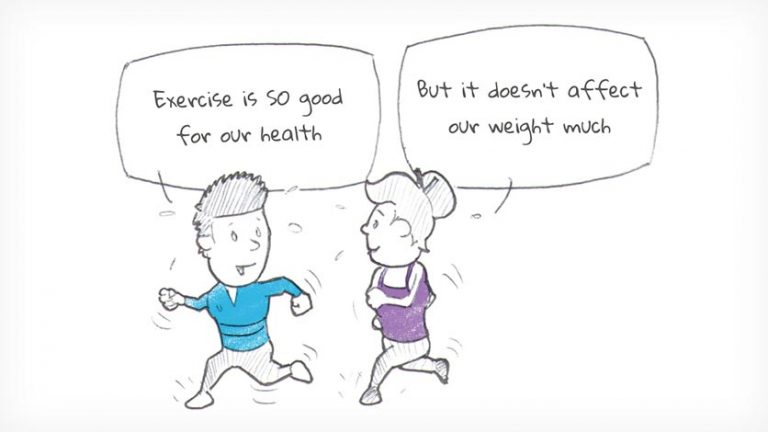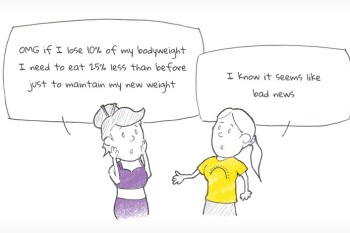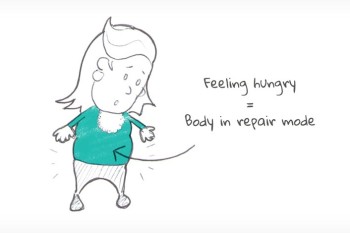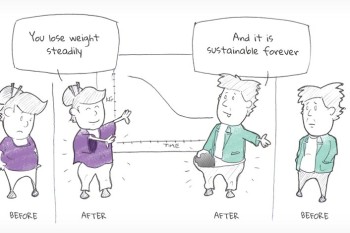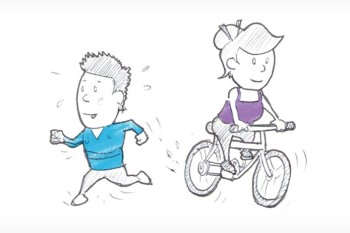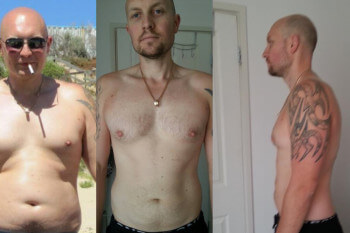Key points about exercise:
-
The calories we burn by taking more exercise do not generally help us lose a significant amount of weight
-
But exercise is good for our general health – and also affects our metabolism in healthy ways – in fact, its benefits are similar to those of fasting
-
And combining exercise with intermittent fasting appears to be an excellent idea – early evidence suggests it increases the benefit of both.
Let’s look at each of these points in turn.
The calories we burn by taking more exercise do not generally help us lose a significant amount of weight
A person who exercises is clearly going to burn more calories than someone who sits at home all day. So, surely exercise will be a good way to lose weight? Unfortunately, no. Studies have found that people following the standard health advice of moderate exercise of around 30 minutes on most days of the week lose hardly any weight.1 There are two main reasons for this:
1) This kind of exercise can make us hungry so we indulge in a treat following our trip to the gym. Usually the treat contains more calories than we were able to burn during our exercise.
2) This kind of exercise can make us more tired and we tend to move less to compensate for the exercise calories expended.
In fact, it seems that the most efficient way of encouraging fat burning, weight loss and the other health benefits is not to spend hours in the gym but to use high intensity interval training (HIIT).
High intensity interval training
If you don’t have the time or inclination to spend hours in the gym or out running, or simply wish to maximize the health benefits of your exercise, you should consider including high intensity interval training (HIIT) into your life.
Research has found that as few as 3 bouts of 20 seconds of high intensity exercise done three times a week can have as many beneficial effects on the body as an hour of running on the treadmill.
Indeed, the author of the Fast Diet book, Dr Michael Mosley was so impressed with the results of his experience of HIIT that he wrote another book: Fast Exercise which explains the science behind HIIT and guides you through how to do it.
Exercise is good for our general health: in fact, its benefits are similar to those of fasting
Two important metabolic improvements from exercise are also benefits of fasting. These are:
-
Increased metabolic flexibility. Exercise encourages the body to use its fat-burning processes, rather than relying on glucose from food. As a result, exercise can reduce metabolic inflexibility – a key factor preventing some people from losing weight. Inside our cells, what happens after exercise is that the mitochondria, which are the parts of our cells that actually release energy from fuel, multiply and any worn out mitochondria are repaired.2 The size of our glycogen stores is increased3 and the machinery that allows fat burning is up-graded so we can use fat as a fuel at higher intensities than previously.4
-
Exercise can reduce insulin resistance5 which is a key element in the development of diabetes, heart disease and other diseases. This is because your muscles burn glucose and during exercise and your body uses more glucose to replenish its glycogen stores. When blood glucose lowers, so do insulin levels and this helps to reduce insulin resistance.5
As well as these positive metabolic changes, exercise has further health benefits unrelated to your metabolism. For example: the heart is also a muscle and, to enable enough blood circulation to provide the oxygen needed for exercise and to remove the carbon dioxide generated, it needs to beat faster and more strongly. Normally, the heart gets 90% of its energy from fats but when beating fast it too will use glucose. The heart will also benefit from its workout by increasing mitochondria, undergoing repair and improving its ability to utilize fuel.6
Curiously, perhaps, your brain can also benefit from exercise. Exactly how this works is unclear, but it seems that exercise triggers release of various brain chemicals that stimulate nerve repair.7
Combining exercise with intermittent fasting appears to increase the benefit of both
The benefits of exercise for the way our bodies function are many, and exercise can compliment our weight loss efforts, but for maximum health we need to attend to both exercise and food (or, rather, absence of food). Many of the metabolic changes that occur with exercise are also seen with fasting. Like fasting, exercise reduces blood glucose and so reduces the risk of diabetes. Like fasting, exercise encourages fat burning and so aids weight loss. Like fasting, exercise aids brain repair.
Learn more about exercise and fasting
More information for the scientifically inclined
What happens in our bodies when we exercise at different levels of intensity? Let’s look at how our muscles use fuel:
-
When the exercise intensity is high, glycogen stores in the muscles are broken down into glucose to provide energy, but in the absence of sufficient oxygen (anaerobic exercise) this process is quite inefficient and fatigue soon develops as the glycogen stores are rapidly depleted in the exercising muscles. Because glycogen stores are relatively small, very high intensity exercise can only be sustained for short periods.
-
At medium exercise intensities, the body will use a mix of glycogen and fat for fuel. The exact mix will depend on how well the muscles are adapted to burning fat and how long the exercise lasts. At first glycogen will dominate but as the exercise continues, more and more fat is burned. Fasting and exercising to deplete glycogen stores encourages the body to use fat more.
-
When exercise intensity is lower and the oxygen supply can keep up with demand (aerobic exercise), release of energy from glycogen stores is more efficient and so the exercise can be maintained for longer before glycogen stores are depleted.
-
At even lower exercise intensities, fat is the main fuel. Fat is more energy dense than glycogen – and we have very large stores of fat – but the chemical processes that release its energy proceed more slowly and so cannot supply energy when it is needed rapidly.

